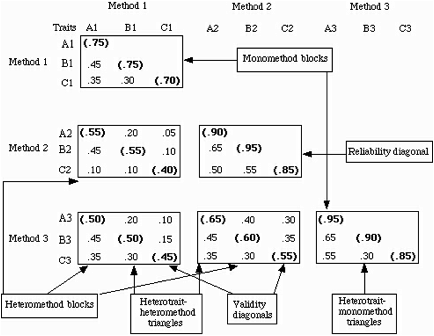Introduced by Donald T. Campbell (1916-1996) and Donald W. Fiske (1916-1983) in 1959, it is one approach to establishing construct validity, and thus convergent and discriminant validity, of different methods measuring various psychological abilities or traits. It consists of the following components that are depicted in the table below:
1. a matrix of two or more theoretically distinct measures (judged to be so on the basis of face validity) assessed by two or more different methods (e.g., parental ratings, peer ratings, teacher ratings).
2. monotrait-monomethod scores (the reliability diagonals): reliability estimates (e.g., internal consistency), not correlations, which would be 1.0, along the main diagonal of the matrix. These values should be the highest in the matrix.
3. monotrait-heteromethod scores (the validity diagonals): correlations among measures of the same variable by different methods that are considered to provide an indication of convergent validity, and which should be reasonably high.
4. heterotrait-monomethod scores (triangles): correlations among different traits measured by the same method. These outcomes are assumed to be evidence of discriminant validty and the degree to which they are due to a methods factor.
5. heterotrait-heteromethod scores (triangles); correlations among different variables measured by different methods, which should be the lowest in the matrix and not greater than the validity coefficients in their respective rows or columns.
6. Monomethod blocks: correlations sharing the same method of measurement.
7. Heteromethod blocks: correlations not sharing the same methods.
The method requires a fully-crosseddesign, a requirement that has worked against its application as it is notalways possible to measure all traits with the selected methods. Onealternative is to use a modified matrix in which the methods factor is left outas convergent and discriminant validity do not essentially require the methodsfactor.
